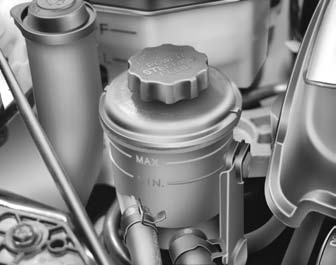Power steering

Checking the power steering fluid
level
With the vehicle on level ground, check
the fluid level in the power steering reservoir
periodically. The fluid should be
between MAX and MIN marks on the
side of the reservoir at the normal temperature.
Before adding power steering fluid, thoroughly clean the area around the reservoir cap to prevent power steering fluid contamination.
If the level is low, add fluid to the MAX level.
In the event the power steering system requires frequent addition of fluid, the vehicle should be inspected by an authorized Kia dealer.
NOTICE
• To avoid damage to the power steering
pump, do not operate the vehicle
for prolonged periods with a low
power steering fluid level.
• Never start the engine when the reservoir tank is empty.
• When adding fluid, be careful that dirt does not get into the tank.
• Insufficient fluid can result in increased steering effort; excessive noise may also be present as the steering wheel is turned.
• The use of the non-specified fluid could reduce the effectiveness of the power steering wheel and cause damage to it.
Use only the specified power steering
fluid. (Refer to "Recommended
Lubricants" later in this section.)
Power steering hose
Check the hoses and hose connections
for leaks or damage before driving the
vehicle.
See also:
Superior Safety Features
Like all Kia vehicles, the 2011 Sorento is equipped with a plethora of
standard safety equipment. All trims come outfitted with driver and passenger
advanced front airbags, front seat-mounted side ...
Lubricants and fluids
Checking the washer fluid
level
The reservoir is translucent so that
you can check the level with a quick
visual inspection.
Check the fluid level in the washer
fluid reservoir and add fluid i ...
Hood
Opening the hood:
1. Pull the release lever on the lower left
side of the instrument panel to unlatch
the hood. The hood should pop open
slightly.
2. Go to the front of the vehicle, raise the ...


